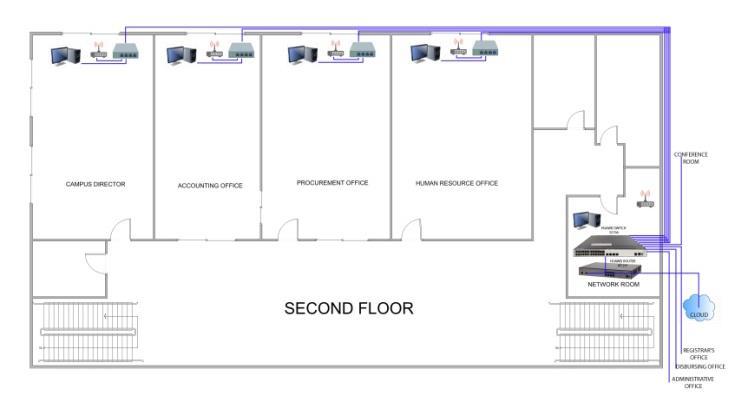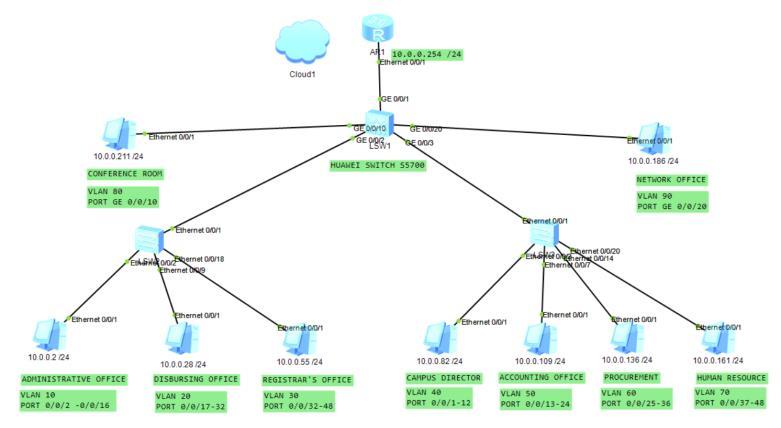International Journal of Advanced Trends in Computer Science and Engineering
Available Online at http://www.warse.org/IJATCSE/static/pdf/file/ijatcse101162022.pdf https://doi.org/10.30534/ijatcse/2022/101162022

Available Online at http://www.warse.org/IJATCSE/static/pdf/file/ijatcse101162022.pdf https://doi.org/10.30534/ijatcse/2022/101162022
Emmer P. Ruaya1 , Mark Van M. Buladaco2
1North Eastern Mindanao State University-Tagbina Campus, Philippines, emmerruaya@gmail.com
2Davao del Norte State College, Institute of Computing, Panabo City
Received Date: October 24, 2022
Accepted Date: November 27, 2022 Published Date: December 06, 2022
Through the advent of the technology computer has become an integral part of the different institutions. As the technology evolves computer networking rapidly impacts everything.Intoday’smodernbusinesscomputer networking plays a vital role in running organization. [11] Computer networking provides to administrators with technological capability on obtaining a substantial amount of high quality, timelyandrelevant informationonorganizational operations at a minimal cost. [10] Implementation of manage networks will reduce the operational, maintenance service, software, hardware cost and provides a high level of security on the network.
In this paper a Virtual Local Area Network VLAN was developed at the 3 storey Administration Building at North Eastern Mindanao State University – Tagbina Campus. An ideal network management on implementing VLAN was proposed on the operation, administration and security. A logical networkdesign was created using the ENSP software with ideal networking equipments and VLAN configuration to improve the office operations.
Key words : VLAN, LAN, network,
Through the advent of the technology computer has become an integral part of the different institutions. As the technology evolves computer networking rapidly impacts everything. In today’s modern business computer plays a vital role in running organization. Technologies related to business transaction, communications, collaboration, accounting, customer relationship management has been drastically powered by computer networks. The computer network enhances the functional performance in different fields and organizations, such as companies and schools. School’s computer network performs so many functions, such as connecting students with the university, faculty, and the library. Most universities today use the network to
provide online education by connecting widely dispersed students with heir professors directly. Computer networking enhances our society to exchange information through interconnection of systems through the purpose of communications and secured transfer of information. Nowadays, secured exchange of information is a priority, most of the network administrators implements VLAN on their respected networks. [1] VLAN (Virtual Local Area Network) is a logical overlay network that groups together a subset of devices that share a physical LAN, isolating the traffic for each group [2] VLAN allows providing security by denying access to members of one VLAN to another unless it was authorized.

On this study the researcher will develop to setup virtual LAN and communicate among one another by breaking broadcast domains. The proposed network study aims to cover a network installation for a new three-floor building NEMSU-Administrationbuilding. The mainplaninvolves a VLAN design that will be able to endure for the future years and also be able to provide the means for any necessary isolationsothatsomedepartmentswillhavelimitedaccessto others.
The main objective of this study is to develop a logical VLAN topologysuitable for the newadministrationbuilding of the North Eastern Mindanao State University – Tagbina Campus. That will withstand with the intense operation of utilization.
Computernetworkinghasbecometheforemostandeffective wayofsharingdata,wherealmostofthedevicesisconnected via networks. Nowadays educational institutions and office administration are heavily relying on the computer networks to transfer data and files to one computer to another. Office individuals are the most benefited on embracing computer network where it enhances data transfer, data security, data
communications and availability of information, convenient on resource sharing boost storage capacity. Moreover, to achieve the efficiency of the network the researcher implements the VLAN on the network, to improve network security and bandwidth management.
The best about virtualization are that it simplifies management. By logically grouping users into the same virtual networks, makes it easy to set up and control policies at a group level. When users physically move workstations, you can keep them on the same network with different equipment.
Using VLAN’s it improves security by minimizing both internal and external threats. Internally, separating users improvessecurityandprivacybyensuringthatuserscanonly access the networks that apply to their responsibilities. External threats are also minimized
Troubleshooting errors on the network can be simpler and fasterwhenusergroupsaresegmentedandisolated fromone another.
VLAN’s network traffic is managed efficiently because networkpacketsaresenttospecificbroadcastdomain sothat yourendusersexperiencebetterperformance. Fewer latency problems on the network may experience
Is an important post activity on computer networking on maintaining the performance of network [1]. Furthermore, it includes configuration of transmission links, installation of networking devices, maintenance and troubleshooting to enhance device performance, etc. These activities are then followed by administration, operation and control, maintenance and troubleshooting and security in order to maintain the desired function of the networks.
Administration is the essential step of network management. It incorporates keeping a record of all facilities likeservers,fiber-opticswitches,routers,and etc. Administration helps on the maintenance and troubleshooting requirements of the network. This method involves inventory control.
Oncethenetworkinstallationisdone,operationcontrol is essential.Inthisstep,networksoftwareisusedtotracethe directionofdatabeingtransmitted;lossofsignalstrength, reception of data packets, etc is taken care of in this step. Administrator can run device inventory, get a visual overviewof their environment, see which nodes are up or down, and see how their infrastructure operates under various loads. Activation, termination, performance control of networking devices is done in this step.
Maintenanceandtroubleshootingaredonetomaintainthe efficiency of a network. In this step, each device is tested for performance, and thenrepair measures are taken. This step includes physical maintenance for the equipment including server upgrades, configuration updates for software, and so on. In severe cases, the devices may require on-field replacement. The device repair, troubleshooting, calibration, and replacement comes under this stage of management.
Security is to prevent third-party intrusion. Various security measures like implementation of security firewall,userauthentication,etccomeunderthisaspectof network management. The Ethernet networks are sensitive to harsh environments, therefore, proofing of outdoor devices, terminating third-party access, etc are adopted under the security stage. Gantt Chart is shown in Table 1 and Capital Expenditures is shown in Table 2.
The types of data served by the network will be reports, bulletins, accounting information, personnel profiles, and web pages. The majority of the data will be text (ASCII and non-ASCII), but there will be some still graphics and possibly a small amount of voice and video (primarily for PC-based teleconferencing).
Data will be created and used at all end stations on the network. The data will be produced bysoftware applications in Windows Office tools such as (Word, Excel, Access, PowerPoint, and Outlook). Other data sources to be supported on at least a limited basis will Accessories (Paint, Notepad, etc.), Zoom Meeting, Google Meet, Media Player, and Photoshop.
At the state level, the users will be administrators, and members of such departments. The maximum estimated numberofusersonthenetworkatanygiventime is50 users.
Three priority levels will be supported: management (top priority), user (medium priority), and background (low priority). Network management processes will receive top-priority service; most network processes will receive medium-priority service; a few processes (e.g., e-mail transfers, backup, etc.) will be given low-priority service. It should be noted that network management will usually consume a small amount of the available bandwidth; this means that management and user processes will usually enjoy identical support.
The networkis to be transparent to the users. Thus, remotely executed applications, file transfers, and so forth should ideally appear to operate as quickly as processes executed within an end-station.
The data indicate that the highest average traffic volume will occur from 8:00 a.m. to 6:00 p.m., Monday through Friday. The peak network traffic volume is expected at two times during the day: 8:00 a.m. to 12:00 noon and 3:00 p.m. to 5:00 p.m. At night and onweekends the network traffic is minimal except for the daily backups of the PCs to the LAN servers. To avoid user complaints, the network is designed for the peak traffic loads, not the average throughput.
Storage requirements need to be large enough to store all officedata.Interviewsandobservations ofusers’present and anticipated storage requirements indicate that each user will need an average of 100 GB data space on each PC. Additionally, the network operating system will occupy about 500 MB on each LAN server. Taking price-performance issues into account, each PC will have a minimum storage capacity of 10 GB, each LAN server will have a minimum storage capacity of 20 GB. A main data server in the State Office will have a 36 GB capacity.
In keeping with user expectations and industry standards, both the LANs and the WAN are expected to operate at 99.9% uptime and an undiscovered error rate of .001%.
A firewall will be used so unauthorized users will be restricted. Part of the security will be Users accounts and passwords that will give limited access. There will be different access capabilities for networkmanagers and users.
The proposed VLAN physical design illustrated on Figure 1 shows the ground floor connecting the Administrative office (VLAN 10), disbursing office (VLAN 20) and registrar’s office (VLAN 30) via switch from network office on 2nd floor. Figure 2 is a 2nd VLAN configuration on Campus Director office (VLAN 40), Accounting office (VLAN 50), Procurement office (VLAN 60), Human Resource office (VLAN 70) and Network office (VLAN 90). Furthermore, Figure 3 shows the physical VLAN connection on conference room (VLAN 80)

Figure 1: Physical network design ground floor.


Figure 2: Physical network design for second floor.
The proposed logical network design Figure 4 is composed of router and various switches which are configured on a Virtual Local Area Network. The network is manage by the main switch, which serves as the trunk switch that is configured to allow access of the switches configured as virtual Local Area network. The network are set to 9 VLAN, the Administrative Office is assigned as VLAN 10, Disbursing office is assigned as VLAN 20, Registrar’s Office is assigned as VLAN 30, Campus Director office is assigned as VLAN 40, Accounting Office is assigned as VLAN 50 and Procurement office is assigned as VLAN 60, Human Resource Office is assigned on VLAN 70, ConferenceRoomassignedonVLAN80andNetworkoffice assigned to VLAN 90. The proposed network was assigned on the network address of 10.0.0.0 IP Address with the gateway IP Address of 10.0.0.245/24. Table 3 shows the Network Cost of ownership
Figure 3: Physical network design for third floor.

Network Cost of Ownership
Table 3: Network Cost of ownership
27. TCO Components 28. Cost
One Time Installation Costs hardware and labor for deployment
29. 870,000.00
Operating Expenses per year30. 780,000.00
Total Capital And Operating Expenditures For The First Year Of Implementation
31. 32. 1,650,000.00
ThemainobjectiveofthisstudyistodevelopanidealVirtual Local Area Network suitable for the new administration building of the North Eastern Mindanao State University –Tagbina Campus. That will withstand with the intense operation of utilization. The propose network design can be followed by the administration on the network activities Table 1.0 Gantt Chart implementation of activities. Furthermore, on purchasing network equipments, storage, computer specifications, subscriptions, communications, administration support and training expenses see Table 2.0 capitalexpenditures Thenetworklogicalconfigurationmust be followed with fewer configurations to prevent future trouble. The administrator is advised to follow the one year planning and implementation of the project.
Thus, the researcher concluded that on implementing of Virtual local area network at NEMSU – Tagbina Campus Administration building can simplify network management and provide computer network with improved security.
[1] Terry Slattery. What is a VLAN (Virtual LAN)? Retrieved November 23, 2022 from https://www.techtarget.com/searchnetworking/defi nition/virtual-LAN
[2] Mathew, A. and Prabhu, S.R.Boselin, A Study on Virtual Local Area Network (VLAN) and Inter-VLAN Routing (October 18, 2017). International Journal of Current Engineering and
Scientific Research (IJCESR), Volume 4, Issue 10, 2017, Available at SSRN: https://ssrn.com/abstract=3055382
[3] Ethernet Network Monitoring, Control, and Management Versitron. Retrieved November 19, 2022 from https://www.versitron.com/whitepaper/guide-to-eth ernet-network-monitoring-control-and-managemen t
[4] Logicalvs.PhysicalNetworkDiagrams-DNSstuff. Retrieved November 10, 2022 from https://www.dnsstuff.com/physical-logical-network -diagram
[5] Sowjanya, N. L., & Anitha, R. (2020). An Efficient VLAN Implementation to decrease Traffic Load in a Network. International Journal of Advanced TrendsinComputerScienceandEngineering, 9(2).
[6] Ramprasath, J., Ramakrishnan, S., Saravana Perumal,P., Sivaprakasam, M., & ManokaranVishnuraj, U. (2016). Secure network implementation using VLAN and ACL. International Journal of Advanced Engineering Research and Science, 3(1), 2349-6495.
[7] Agwu, Chukwuemeka & Nwogbaga, Nweso & Chukwuka, Ojiugwo. (2015). The Proposed Roles of VLAN and Inter-VLAN Routing in Effective Distribution of Network Services in Ebonyi State University. International Journal of Science and Research (IJSR). 4. 2608-2615
[8] What is a VLAN (Virtual LAN)? Retrieved November 16, 2022from https://www.techtarget.com/searchnetworking/defi nition/virtual-LAN
[9] Tambe, S. S. (2015). Understanding Virtual Local Area Networks. International Journal of Engineering Trends and Technology, 25(4), 174-176.
[10] Buladaco,M.V.M.,Necio,G.C.,Pilongo,O.B.,& Timosan, J. Q. (2021). A Proposed Ideal Network Design for Collaborative Workspace Businesses. InternationalJournal, 10(2).
[11] Gardner, W. L., & Schermerhorn, J. R. (1988). Computer Networks and the Changing Nature of Managerial Work. Public Productivity Review,11(4),85. doi:10.2307/3379905 10.2307/3379905 page 90